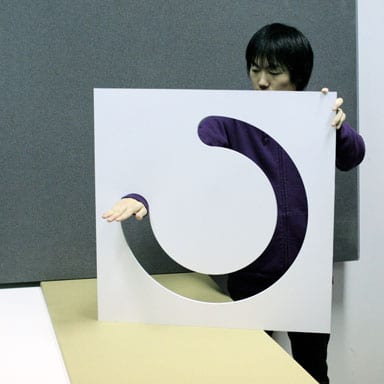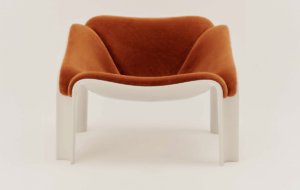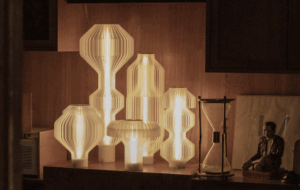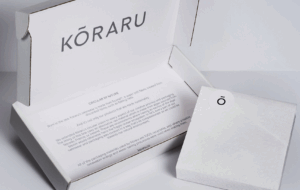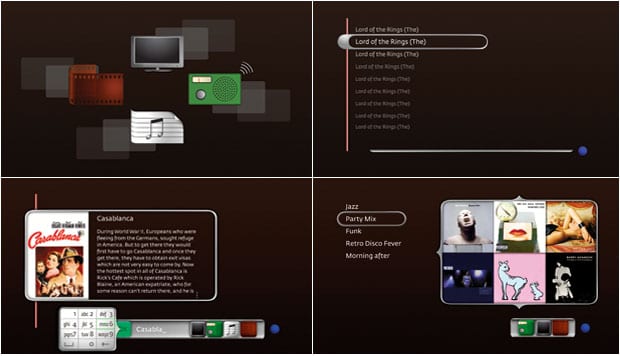
words Justin McGuirk
Who does the worlds biggest microchip manufacturer turn to when it wants to see the future? A company like Intel is in the business of long-term betting, and it can’t afford to get it wrong. So it’s working with some unlikely people in its quest to steer the direction of consumer electronics – not computer scientists, but a group of London-based product and interaction designers… and their students.
What are the payment rituals of a cashless society? Will we navigate our interactive TVs by gesture? These are the kind of questions being considered by the product designers Doshi Levien and the interaction designers Dunne & Raby and Bill Gaver, all of whom have been developing projects for the Oregon-based microprocessor giant.
“It’s rare for companies to fund people who are quite as experimental as Dunne & Raby,” says Bill Gaver, who leads the Interactive Research Studio at Goldsmiths College. It’s also unusual that Intel, a giant in an industry where research is normally shrouded in secrecy, is willing to talk about this experimentation.
“We’re in a business where you have to really foresee the future,” says Wendy March of Intel’s People and Practices Research Group. “You’re creating something for a market that doesn’t even exist.” March, an interaction designer herself, belongs to a stratum of anthropologists and sociologists within the company who are looking at how human behaviour is changing with the emergence of digital technology – or, perhaps more appropriately, how technology needs to cater to people.
“What will people want?” asks Genevieve Bell, director of Intel’s User Experience department. “It requires attention to everyday society. Culture and society don’t change as fast as technology does.” Creating a microchip is a three- to seven-year commitment, which means Intel has to be pretty confident about what the market is going to look like in the coming decade. And since microchips are the brains of any technological device, Intel’s research interests are as broad as any human activity that uses a gadget – they range from laptops and mobile phones to health and fitness devices and payment systems, all of which have intricate behavioural patterns associated with them.
Designers are useful researchers because they make these behavioural changes tangible. “Prototypes are so much smarter than papers,” says Genevieve Bell, an anthropologist by training. “When you work in an engineering company, finding ways of communicating the ideas is just as important as the work itself.”
March approached Dunne & Raby with a project that was “off road map”, as it’s known at Intel. She asked Dunne to set his students on the Design Interactions course at the Royal College of Art to imagine the future of money. In a world where e-money has replaced cash, Intel’s chips would have a pivotal role to play in the most fundamental of social transactions.
A number of students concentrated on the ritualistic dimension of payment, such as Gunnar Green, who devised a series of hand gestures that signified certain values. Others, such as Kenichi Okada, focused on how to bring the tangibility back to spending electronically. At the more plausible end was a project by Chris Woebken that proposed that if you were paying for an expensive meal, you might swipe your debit card that little bit further. But then the point was to think about financial transactions in the freest possible context, not necessarily to produce plausible outcomes.
“We got to work with psychologists, anthropologists, ethnographers, sociologists and computer scientists,” says Dunne. “You can’t be sure what Intel will take away from it. You don’t know how something you’re doing can have a commercial or technological outcome. But the assumption is that they’ll find something of value, so we just tried to make the project as rich as possible.”
“It’s a springboard for us,” says March, who will present the projects to Intel’s senior executives. “We use it to explain a point we’re trying to make, as an illustration of some new way of thinking about things.”
But not all Intel’s research projects are this “blue sky”. Bell asked product designers Doshi Levien, best known for the rich cultural references they have brought to everything from saucepans for Tefal to furniture for Moroso, to design an interface for interactive television. “There’s been a lot of talk about interactive TV and broadband broadcasting, so I was really interested in starting to think about what television might look like in its next incarnation,” says Bell.
“Part of the challenge was to think about how to drive this reinvention of TV without breaking what it is that consumers love about it – so, not thinking about it from a technology perspective but from a deep-seated perspective based around objects and materials, and Doshi Levien, in some ways, are better at doing that than almost anyone else right now.”
The challenge for Doshi Levien was not to imagine a perfect future scenario but to work with technology that already exists. The duo had to devise an interface that could accommodate everything from channel hopping to internet shopping but that was easy and intuitive to use. They wanted to create a new visual language that broke away from, for instance, the tedious reliance on scrolling through lists. “TV interfaces have a very banal, office-like aesthetic – but this is something for the home,” says Nipa Doshi.
Using a remote control with motion sensors, much like a Nintendo Wii, their system is navigated by directional movements of the wrist. It is also visually rich, using icons and a graphic language of forms that they would commonly bring to their product design. “Intel wanted this to have an identity and a desirability, the way you might design a product,” says Doshi. “Everything virtual is creating a lot of anxiety for people – like digital photography, you miss the tangibility of these things. The virtual world should be creating its own language.”
Bill Gaver, who heads the Interactive Research Studio at Goldsmiths, was approached to look into another imminent development, home sensing. The question was how you monitor, say, the disabled or the aged, in their homes without invading their privacy Big Brother-style. Gaver and his students developed a series of products incorporating things like motion sensors, the idea being that these generate enough information for a carer or member of the family to have a good idea if something might be wrong.
“We like working with Intel because they have a strong sociology component – and so a background of understanding people,” says Gaver. “And they’re developing technology for people in a way many other companies don’t.”
For Intel, the outcome is clearer insight, not a series of products. “We have a desire to get the broadest range of different input into the organisation,” says Bell. “And I think design can be at its most useful not in its ability to create physical objects as such but in its ability to redirect our thinking.”
